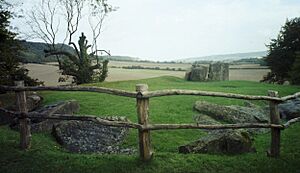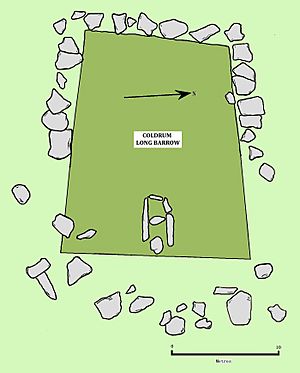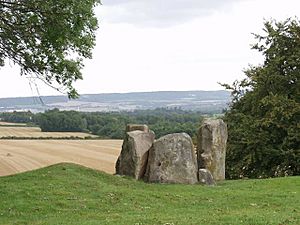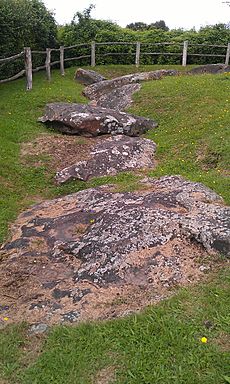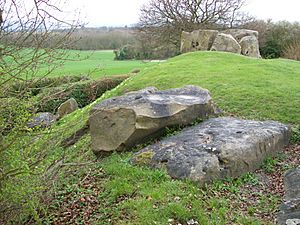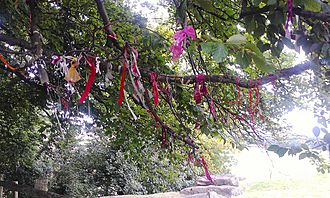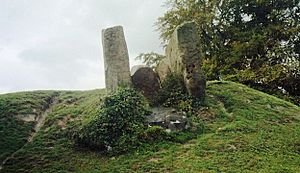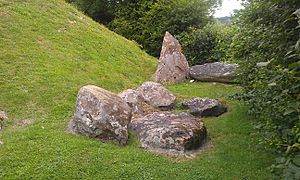Coldrum Long Barrow facts for kids
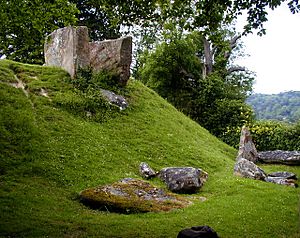
The eastern side of the monument, showing the surviving stone burial chamber at the top of the slope and fallen sarsens at the bottom
|
|
| Lua error in Module:Location_map at line 420: attempt to index field 'wikibase' (a nil value). | |
| Established | Early Neolithic |
|---|---|
| Location | Trottiscliffe, Kent |
| Type | Long barrow |
The Coldrum Long Barrow, also known as the Coldrum Stones, is an ancient burial mound near Trottiscliffe in Kent, England. It was built a very long time ago, around 4,000 BCE, during a period called the Early Neolithic. Today, it is mostly in ruins, but it's still a fascinating place to visit.
Archaeologists believe that people who raised animals for food built this monument. This was shortly after farming arrived in Britain from Europe. The Coldrum Stones are part of a group of similar large stone structures called the Medway Megaliths. These were built near the River Medway, and Coldrum is one of the best-preserved among them. Other nearby sites include Addington Long Barrow and Chestnuts Long Barrow.
The long barrow was made from earth and about fifty large local stones called sarsens. It had an earthen mound with a stone chamber inside its eastern end. Human remains were placed in this chamber at least twice during the Early Neolithic period. Scientists have studied these remains and found at least seventeen people, including men, women, and children. Like other barrows, Coldrum was likely a tomb for the dead, possibly used to honor ancestors. It might also have had other important religious or cultural meanings.
After the Early Neolithic, the Coldrum Long Barrow slowly fell apart. Some damage might have happened later, perhaps by people looking for treasure. Over time, local stories grew around the site, like tales of a buried prince. In the 1800s, people interested in history, called antiquarians, started studying the stones. Later, in the early 1900s, archaeologists dug up parts of the site to learn more. In 1926, the National Trust took over the site. Today, it's open for everyone to visit for free. People still come here for various reasons, including May Day morris dances and modern Pagan rituals.
Contents
What is the Coldrum Long Barrow?
The Coldrum Stones are named after a nearby farm that no longer exists. This ancient monument is in a quiet spot northeast of Trottiscliffe village in Kent. It's also about 500 meters (550 yards) from an old path called the Pilgrims' Way. You can reach the tomb by walking along a path called Coldrum Lane. The closest car park is in Trottiscliffe.
Who built the Coldrum Stones?
The Early Neolithic period was a time of big change in Britain. Between 4500 and 3800 BCE, people started farming instead of hunting and gathering. This new way of life came from Europe. Kent was an important area for new settlers and visitors because it was close to Europe and the River Thames.
Most of Britain was covered in forests back then. People in the Early Neolithic mainly raised cattle and moved around a lot. They didn't build many permanent homes.
What are the Medway Megaliths?
During the Early Neolithic, people in Western Europe began building huge structures. These included chambered long barrows. These were long, rectangular mounds of earth with a stone chamber inside. These chambers often held the remains of the dead. People were usually buried together in these tombs. This tradition of building stone tombs spread from Europe to Britain around 4,000 BCE. These were some of the first widespread stone buildings ever made by humans.
The Medway Megaliths are a group of these large stone monuments found along the River Medway in Kent. They are the only group of megalithic (large stone) monuments in eastern England. Even though they are now in ruins, they were once very impressive. Archaeologists say they are some of the most interesting ancient sites in Kent.
The Medway Megaliths are split into two groups: one west of the River Medway and one east. The western group includes Coldrum Long Barrow, Addington Long Barrow, and Chestnuts Long Barrow. The eastern group has Kit's Coty House and Little Kit's Coty House. Other stones, like the Coffin Stone, might also have been part of these structures. We don't know if they were all built at the same time or if they had different purposes.
All the Medway long barrows look similar. They are all aligned from east to west and have a stone chamber at the eastern end. They were built using sarsen stones, which are strong, hard stones found naturally in Kent. Builders would have moved these huge stones to the site.
These shared features show that the people who built them had a strong local style. However, each monument also has unique details. These differences might be because the tombs were changed over time. Archaeologists are still trying to figure out where the builders of these monuments originally came from.
How was Coldrum Long Barrow built?
The Coldrum Long Barrow originally had a stone chamber covered by a low earth mound. Large flat stones, called kerb-stones, surrounded the mound. About 50 stones were used to build it. The mound is shaped like a rectangle, about 20 meters (65 feet) long. It's wider at the eastern end, where the chamber is, measuring about 15 meters (50 feet) across.
The builders placed the Coldrum Stones on top of a small ridge, facing east towards the River Medway. It's hard to know what the view was like back then because we don't know how many trees were around. If there weren't many trees, people would have had amazing 360-degree views. The monument points towards the North Downs and the Medway Valley, just like the other Medway Megaliths. Some experts think the barrow might have been built near a settlement, connecting the tomb to the daily lives of the people.
Coldrum Long Barrow is quite separate from the other Medway Megaliths. It's possible that other similar tombs were once nearby but have since been destroyed or buried.
The burial chamber
The inner chamber is about 4 meters (13 feet) long and 1.6 meters (5 feet 6 inches) wide. It might have been even bigger when it was first built. The chamber was at least 2 meters (6 feet 6 inches) tall inside. Today, the northern side of the chamber has two large stone slabs. The southern side has one very long slab.
The western end of the chamber is closed off by another slab. A broken stone lies at the eastern opening. When archaeologists dug here, they found that flint stones were used to support the sarsen slabs. In the 20th century, concrete was added to help keep the stones standing.
It's possible that there was a grand entrance in front of the chamber, like at other ancient tombs. Many large stones that have fallen down the slope might have been part of this entrance.
The mound and kerb-stones
The earth mound that once covered the tomb is now only about 45 centimeters (1 foot 6 inches) high. In the 1800s, it was taller. It's likely that the mound originally had a ditch around it, where the kerb-stones now sit.
The kerb-stones around the tomb are arranged in a pattern. Those on the northern side are mostly straight, while those on the southern side are smaller and more uneven. It's thought that there might have been a wall made of ironstone blocks, similar to the Chestnuts Long Barrow.
Some of the kerb-stones show signs of being rubbed and polished. This might be from people sharpening flint tools or other stone axe-blades on them. These tools could have been used to cut wood for building the tomb. Similar marks have been found at other ancient sites like Stonehenge.
Who was buried there?
Archaeologists once thought the Coldrum tomb could have held over a hundred people. Early excavations in the 1900s found what they believed were the remains of twenty-two humans. A scientist named Sir Arthur Keith studied these bones in 1913. He thought the ancient people of Kent looked similar to people living there in his time.
In the early 2000s, a new team of scientists led by Michael Wysocki re-examined the bones. They used modern methods to learn more about the people buried there. Their report, published in 2013, said there were at least seventeen individuals. These included nine adults (five men, four women), two teenagers, four older children, and two younger children (one around five years old, another very young).
Some scientists believed that the skulls found showed similar features, suggesting they might have been from one family or related families. However, others say this could also mean the population was small, and many people were related.
The new study also found signs of injury on three of the skulls. Scientists also looked at the diet of these ancient people. They found that the people ate a lot of animal protein and, over time, started eating more food from freshwater rivers or estuaries.
By using Radiocarbon dating, scientists estimated when some of the people died. Some remains were placed in the tomb between 3980–3800 BCE. After a break of about 60–350 years, more remains were added, starting around 3730–3540 BCE. This dating tells us when people were buried, but not necessarily the exact date the tomb was built.
How has the monument changed over time?
All ancient stone tombs from the Early Neolithic have been damaged over time. The Coldrum Stones are considered "Kent's least damaged" long barrow, but they have still changed a lot in 6,000 years. The eastern side has mostly collapsed, with stones falling down the slope. Some stones at the bottom might even be ones that farmers moved there from nearby fields.
Archaeologists think that some ancient tombs, like Chestnuts Long Barrow, were deliberately destroyed. The same might have happened to the Coldrum Stones. Some believe Christians in the 1200s or 1300s might have damaged non-Christian monuments. Others suggest treasure hunters destroyed them. There's a record from 1237 that ordered opening mounds on the Isle of Wight to find treasure, and this practice might have spread to Kent. Later, locals might have taken stones and earth from the damaged tomb to use for building.
Stories and modern uses
In 1946, a folklorist named John H. Evans wrote about a local story that a battle was fought at the Coldrum Stones, and a "Black Prince" was buried inside. He thought this story might have come from historians who believed the ancient Battle of Aylesford happened nearby.
Evans also noted a common local belief that it was impossible to count the exact number of stones at the Medway Megaliths. This "countless stones" story is found at many other ancient sites in Britain. It might come from an old belief that these large stones had a life of their own.
Many modern Pagan religions use the Medway Megaliths, including the Coldrum Stones, for their ceremonies. Pagans have been active at Coldrum since at least the late 1980s. They often see these sites as connected to ancestors and as places of "earth energy". They feel a link to the ancient people who built them and to the idea of the dead resting there. They also believe the sites are on "ley lines", which are invisible lines of energy.
Pagans visit the site alone or in groups to meditate, pray, or perform rituals. Some have even reported having visions there. A modern Druid group holds regular ceremonies at the site, especially during their eight yearly festivals. The Coldrum Stones have also been used for Pagan rites of passage, like a handfasting (a Wiccan marriage ceremony). Some Pagans have also held rituals there for political reasons, like protesting against new railway lines or fracking.
In the early 2000s, a tradition began where the Hartley Morris Men, a morris dancing group, meet at the site at dawn every May Day. They perform dances among the stones and sing to "sing up the sun." The trees near the Coldrum Stones have become "rag trees," with hundreds of colorful ribbons tied to their branches. This is a folk custom practiced by Pagans and others who visit the site to make wishes or offerings. In 2014, runic carvings of the Norse gods Thor and Odin were also seen on the tree trunks, likely carved by Heathens (a religious movement that worships these gods).
How have people studied the Coldrum Stones?
Early studies
The first written accounts of Coldrum Long Barrow were not published. In the early 1800s, a Reverend named Mark Noble supposedly drew a plan of the site. Later, in the 1840s, Reverend Beale Poste wrote about the monument, calling it "Druidical Remains at Coldrum." He thought the name "Coldrum" came from an old Celtic word and that ancient chiefs were buried there. He also reported that skulls had been found at the site in 1804 and 1825. In 1844, Thomas Wright published a short note about the Coldrum Stones. He described a "smaller circle of stones" with a "subterranean cromlech" (stone chamber) in the middle. He also mentioned a local story that a line of stones connected Coldrum to Kit's Coty House.
In 1857, J. M. Kemble and Reverend Larking dug at the site. They thought it was a stone circle and found Anglo-Saxon pottery. They also noted that the monument was sometimes called the Adscombe Stones. In 1863, members of the Archaeological Institute visited the site. Charles Moore Jessop described it as a "Celtic" stone circle.
In 1869, A. L. Lewis visited and heard stories from locals about a skull found in the chamber, which they thought belonged to a "gypsy." Later, it was said that two people digging without permission found a human skeleton, and its skull was re-buried in a churchyard. In 1878, Lewis noted that few tourists visited Coldrum compared to Kit's Coty House. He thought Coldrum had two separate parts: a chamber and an "oval" of stones. In 1880, archaeologist Flinders Petrie described the stones as forming a "rectilinear enclosure" around the chamber and drew a basic plan.
In 1889, George Payne and A. A. Arnold found the monument, which was overgrown with plants. Payne returned the next year after the plants were cleared. In his 1893 book, Payne said that no one had properly recorded the stones or made a plan, even though Petrie's plan existed. He got permission to have a survey done in 1892. Payne called the Coldrum Stones "the finest monument of its class in the county." He believed it was a tomb from before the Romans came to Britain. He also heard a story about stone paths connecting Coldrum to Addington Long Barrow, but he couldn't find any proof.
In 1904, George Clinch wrote about the Coldrum Stones, calling them "the most remarkable and the least known" of the Medway Megaliths. He thought its design suggested it was built later in the Neolithic period. He urged for the site to be protected. In the same publication, Lewis disagreed that the monument was ever covered by an earth mound. He still thought it was a stone circle with a central shrine.
Archaeological digs
The Coldrum Stones have been dug up by archaeologists many times. On April 16, 1910, F. J. Bennett, an amateur archaeologist, started digging. He soon found human bones just below the surface. He returned in August 1910 with his niece and her husband, who were dentists interested in skulls. They found more bones and were able to put together a human skull. A few days later, he found a second skull, more bones, a flint tool, and pottery pieces (later identified as Anglo-Saxon).
In 2009, archaeologists Martin Smith and Megan Brickley praised Bennett's work for being well-recorded with drawings and photos. Bennett believed the human remains were from human sacrifices in fertility rituals. However, John H. Evans later said we "have no means of knowing" if human sacrifice happened there.
In September 1922, E. W. Filkins continued digging at Coldrum with Charles Gilbert. They cleared a lot of overgrown plants. They found more human remains, which were given to Sir Arthur Keith. Between 1939 and 1945, some human remains found at the site were reburied in the churchyard at Trottiscliffe. Filkins's dig uncovered all the existing sarsen stones and supported the chamber stones with concrete. Even though his methods weren't perfect by today's standards, his work was very thorough for its time.
Managed by The National Trust
In 1924, archaeologist O. G. S. Crawford listed the Coldrum Stones with the other Medway Megaliths. In 1926, the Coldrum Stones were given to The National Trust. They dedicated it as a memorial to Benjamin Harrison, a historian from Kent. A plaque was put up, but it incorrectly called the monument a "stone circle." In 1953, archaeologist Leslie Grinsell hoped this mistake would be fixed. The site is still owned by the Trust and is open to visitors all year round for free. The Trust's website suggests looking for "stunning views from the top of the barrow." Many experts consider Coldrum to be the most impressive and complete of the Medway Megaliths.
Pagans who use the Coldrum Stones are generally happy with how the National Trust manages the site, though some wish it had better access for disabled visitors. There's a scorched patch of earth in the middle of the monument, possibly from fires. The Trust warden leaves it there to encourage people to light fires in the same spot, away from the stones. The site also sometimes has a problem with litter, which Pagans who visit regularly help to clean up.
See also
 In Spanish: Túmulo alargado de Coldrum para niños
In Spanish: Túmulo alargado de Coldrum para niños


